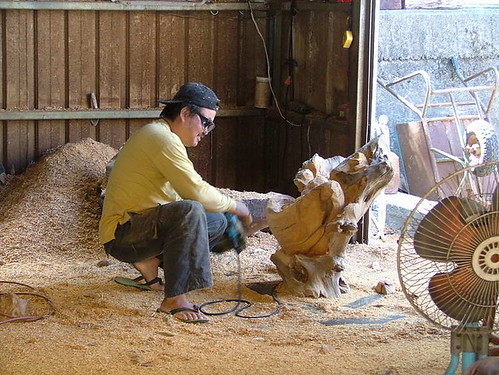Nick Aspinwall turned in a very interesting piece at the News Lens on tree poaching in Taiwan and its relationship to the wood carving industry in Sanyi in Miaoli. The piece is excellent, read it. An excerpt:
Lee’s father, who asked not to be named, joined many others in working only with legal imported wood after the Forestry Bureau instituted a nationwide logging ban in 1991. However, domestic wood products – such as essential oils drawn from felled trees, elaborate life-sized sculptures, and irregular pieces of wood known as burl coveted for their unique, intricate patterns – are still openly sold in Sanyi to a robust market of Taiwanese and Chinese buyers. Shopkeepers worry little about police interference, openly advertising cypress wood from the forests of Alishan and Nantou County.Aspinwall also observes an interesting intersection of various illegalities:
To stop illegal logging, the government has mostly aimed for the source, targeting poachers – colloquially referred to as 山老鼠, or “mountain rats.” Many of those hired to poach trees are runaway migrant workers, who leave their jobs to join gang-affiliated groups operating in central Taiwan’s remote old growth forests. The eldest and most prolific of Taiwan’s trees are also its most coveted.Runaway migrant workers are common in fruit and vegetable growing regions in the mountains, where they are employed as workers. Farmers can pay them in food and little else, since they have nowhere else to go.
Aspinwall gives a thumbnail of history:
Taiwan yellow cypress, often called Hinoki (its Japanese name), was first logged when Japan occupied the island between 1912 and 1945. Once the Kuomintang came to power, its Forestry Bureau operated as a for-profit state industry which exported cypress to Japan, decimating Taiwan’s primeval forests. In response to growing fears that old-growth trees would be lost forever, the logging of centennial trees was banned in 1990, and ban on logging in all natural forests was instituted in 1991.This paper gives a fuller account:
The history of forest conservation and restoration in Taiwan is closely linked to the economic development of the island. Timber harvesting peaked during the Japanese colonial period and immediately following World War II. Large areas of valuable timber, primarily cypress, spruce, and camphor, were cut and shipped primarily to Japan. Economic pressures led to an aggressive management, with plantations of native species and timber harvesting program through the 1950s to the 1970s, with an average of 1,552,600 m3 harvested from 1965 to 1975, corresponding to about 18,000 ha cut annually (Lu et al., 2001). These levels of harvesting brought petitions from citizens and environmental protection groups urging forest protection. This intensive level of exploitation was essentially halted with the national forestry management policy of 1976 (Wang, 1997). Since then, the emphasis of forest management in Taiwan has shifted almost entirely from timber production to forest protection. After 1977, timber was harvested mainly from forest plantations with an annual cut of about 100,000 m3 and by 1990, 99% of Taiwan’s timber supply was imported (Wang, 1997; Lu et al., 2001). Currently, national forest lands are managed almost exclusively for the purposes of streamflow regulation, erosion control, and conservation of biological diversity. Under this new approach, the harvesting-reforestation approach is no longer viable and alternatives need to be devised.It's quite interesting that public pressure halted the destruction of Taiwan's forests, highlighting how the state will respond to the public even in an authoritarian state where dissent can be suppressed. Such articles also show how criminal exploitation of natural resources is a threat not only to the resources themselves, but to regional biodiversity: when big trees are lost the whole forest suffers.
My man Drew pointed out on Facebook that the linkage between illegal logging and the production of wood artifacts for the tourist trade gives lie to the claim that tourism is good because it is sustainable. What actually happens is that the damage takes place outside the area frequented by tourists....
_______________________
[Taiwan] Don't miss the comments below! And check out my blog and its sidebars for events, links to previous posts and picture posts, and scores of links to other Taiwan blogs and forums!

No comments:
Post a Comment
Note: Only a member of this blog may post a comment.